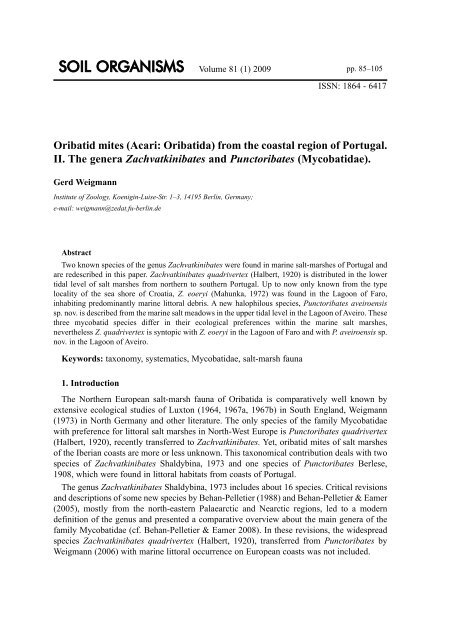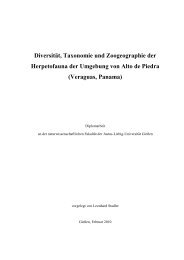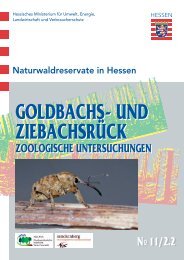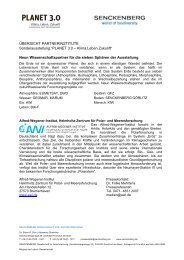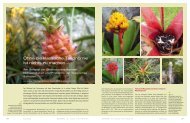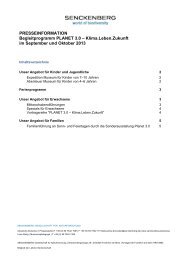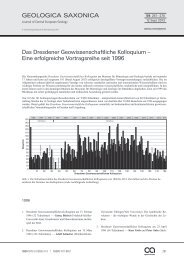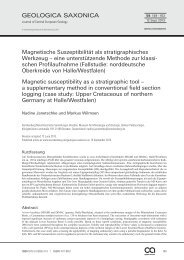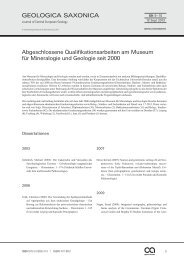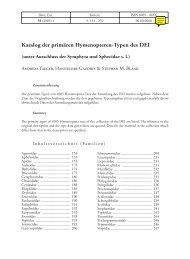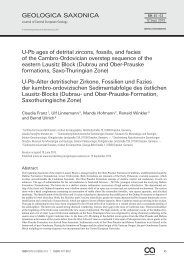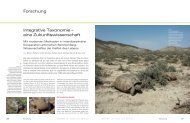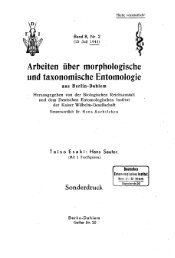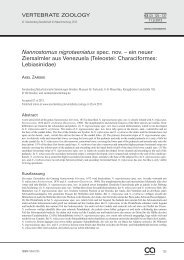Oribatid Mites (Acari: Oribatida) - Senckenberg
Oribatid Mites (Acari: Oribatida) - Senckenberg
Oribatid Mites (Acari: Oribatida) - Senckenberg
Create successful ePaper yourself
Turn your PDF publications into a flip-book with our unique Google optimized e-Paper software.
SOIL ORGANISMS Volume 81 (1) 2009 pp. 85–105<br />
ISSN: 1864 - 6417<br />
<strong>Oribatid</strong> mites (<strong>Acari</strong>: <strong>Oribatid</strong>a) from the coastal region of Portugal.<br />
II. The genera Zachvatkinibates and Punctoribates (Mycobatidae).<br />
Gerd Weigmann<br />
Institute of Zoology, Koenigin-Luise-Str. 1–3, 14195 Berlin, Germany;<br />
e-mail: weigmann@zedat.fu-berlin.de<br />
Abstract<br />
Two known species of the genus Zachvatkinibates were found in marine salt-marshes of Portugal and<br />
are redescribed in this paper. Zachvatkinibates quadrivertex (Halbert, 1920) is distributed in the lower<br />
tidal level of salt marshes from northern to southern Portugal. Up to now only known from the type<br />
locality of the sea shore of Croatia, Z. eoeryi (Mahunka, 1972) was found in the Lagoon of Faro,<br />
inhabiting predominantly marine littoral debris. A new halophilous species, Punctoribates aveiroensis<br />
sp. nov. is described from the marine salt meadows in the upper tidal level in the Lagoon of Aveiro. These<br />
three mycobatid species differ in their ecological preferences within the marine salt marshes,<br />
nevertheless Z. quadrivertex is syntopic with Z. eoeryi in the Lagoon of Faro and with P. aveiroensis sp.<br />
nov. in the Lagoon of Aveiro.<br />
Keywords: taxonomy, systematics, Mycobatidae, salt-marsh fauna<br />
1. Introduction<br />
The Northern European salt-marsh fauna of <strong>Oribatid</strong>a is comparatively well known by<br />
extensive ecological studies of Luxton (1964, 1967a, 1967b) in South England, Weigmann<br />
(1973) in North Germany and other literature. The only species of the family Mycobatidae<br />
with preference for littoral salt marshes in North-West Europe is Punctoribates quadrivertex<br />
(Halbert, 1920), recently transferred to Zachvatkinibates. Yet, oribatid mites of salt marshes<br />
of the Iberian coasts are more or less unknown. This taxonomical contribution deals with two<br />
species of Zachvatkinibates Shaldybina, 1973 and one species of Punctoribates Berlese,<br />
1908, which were found in littoral habitats from coasts of Portugal.<br />
The genus Zachvatkinibates Shaldybina, 1973 includes about 16 species. Critical revisions<br />
and descriptions of some new species by Behan-Pelletier (1988) and Behan-Pelletier & Eamer<br />
(2005), mostly from the north-eastern Palaearctic and Nearctic regions, led to a modern<br />
definition of the genus and presented a comparative overview about the main genera of the<br />
family Mycobatidae (cf. Behan-Pelletier & Eamer 2008). In these revisions, the widespread<br />
species Zachvatkinibates quadrivertex (Halbert, 1920), transferred from Punctoribates by<br />
Weigmann (2006) with marine littoral occurrence on European coasts was not included.
86<br />
Gerd Weigmann<br />
For the Iberian Peninsula, only Zachvatkinibates perlongus (Balogh, 1959) was reported<br />
(Subías & Minguez 2001). Pérez-Iñigo (1993) listed this species as Punctoribates perlongus<br />
and redescribed it as type species of Schweizerzetes Mahunka, 2001. This species differs well<br />
from the other Zachvatkinibates species (rostral indention, monodactylous legs and other<br />
characters). The species lives in non-littoral habitats in Hungary, the Swiss Alps and northwestern<br />
Spain, as cited in Pérez-Iñigo (1993) and Mahunka (2001), and is not discussed<br />
further herein. Recently, Subías (2008) regarded Schweizerzetes as a junior synonym of<br />
Zachvatkinibates.<br />
During my ecological studies of oribatid mites in salt-marshes of the Portuguese coasts,<br />
Zachvatkinibates quadrivertex was found in several localities. Most surprisingly, another<br />
species was found on the shore of the Lagoon of Faro, living especially in the marine debris<br />
of rotting Zostera. After the study of a paratype specimen, deposited in the Museum of<br />
Natural History Geneva, the latter species was determined as Zachvatkinibates eoeryi<br />
(Mahunka, 1972). This species was synonymised erroneously with Z. quadrivertex (in<br />
Weigmann 2006). Both species are redescribed below.<br />
Punctoribates Berlese, 1908 is a species-rich genus with some subgenera (according to<br />
Subías 2008), and most known species are distributed in the Holarctic region. Records of the<br />
species of Punctoribates s. str. in the Iberian Peninsula are P. punctum (C. L. Koch, 1839) and<br />
P. sellnicki Willmann, 1928 (Pérez-Iñigo 1993, Subías & Gil-Martin 1997). Iberian species of<br />
the subgenus Minguezetes Subías, Kawash & Ruiz, 1990, are P. conjunctus Subías, Kawash<br />
& Ruiz, 1990, and P. hexagonus Berlese, 1908; the latter with the junior synonym P.<br />
hygrophilus Miheleie, 1957 (cf. Subías 2008; as species dubia in Pérez-Iñigo 1993, p. 155).<br />
Weigmann (2006) regarded Minguezetes as a junior synonym of Punctoribates, which was<br />
confirmed and substantiated by Behan-Pelletier & Eamer (2008).<br />
In the salt marshes of the Lagoon of Aveiro, a new species of Punctoribates was found,<br />
which is described in this contribution.<br />
2. Materials and methods<br />
The samples from Portugal were collected by the author in April and May 1971 from Rio<br />
Minho at the northern border to Spain, from the estuary of Rio Cavado, from the Lagoon of<br />
Aveiro and from the Lagoon of Faro in the south of Portugal.<br />
Po 19–24: Samples in salt-marsh meadow between Caminha and Seixas (41°53’N, 8°50’E)<br />
on the shore of Rio Minho, 15 April 1971. From lower level with Puccinellia grass up to<br />
upper salt meadow with Festuca and Armeria maritima.<br />
Po 13–16: Samples in salt-marsh meadow near Fão (41°30.40’N, 8°46’E) on the estuary<br />
shore of Rio Cavado, 14 April 1971. Lower level with Puccinellia grass, median level with<br />
Festuca, Armeria maritima and Plantago coronopus.<br />
Po 35–51: Samples in the Lagoon of Aveiro, 21 April 1971, in the northern part from<br />
Quintas de Norte to Torreira (40°46.30’N, 8°41.35’E), in the southern part near the opening<br />
to the Atlantic at Costa Nova (40°37.30’N, 8°44.45’E). Salt-marsh meadows, in the north of<br />
the lagoon with brackish water, in the south with full saline water.<br />
Po 58–83: Samples in the Lagoon of Faro (‘Ria Formosa’), western part (37°01’N,<br />
7°59.30’E). salt marshes with halophilous scrubs, dominated by perennial vegetation of the<br />
Chenopodiaceae (Sarcocornia, Arthrocnemum, Atriplex, Suaeda). 29 April–1 May 1971.
<strong>Oribatid</strong> mites of Portugal. II 87<br />
The samples were taken semi-quantitatively with a special shovel, about 250 cm², 1–2 cm<br />
depth. The mites were extracted using a modified Tullgren apparatus. The specimens were<br />
preserved in ethanol and after clearing they were studied microscopically in lactic acid on<br />
cavity slides.<br />
3. Zachvatkinibates Shaldybina, 1973<br />
Differential diagnosis<br />
According to Behan-Pelletier and Eamer (2005) the adults of this genus are unique among<br />
the Mycobatidae in having the following combination of character states: rounded, convex<br />
medial process on anterior tectum of notogaster; pair of thickened bands on notogaster<br />
bordering medial process; posterior notogastral tectum incomplete medially, indicated by a<br />
wide emargination or a narrow slit bordered by overlapping tectal lobes; subcapitulum<br />
without mental tectum; lenticulus absent; octotaxic system expressed as porose areas,<br />
sexually dimorphic or not. General diagnostic characters of Mycobatidae (Grandjean 1954,<br />
Behan-Pelletier & Eamer 2008) are not repeated in the following descriptions.<br />
Zachvatkinibates quadrivertex (Halbert, 1920)<br />
Oribata quadrivertex Halbert, 1920: Proc. r. Ir. Acad. 35B: 131<br />
Punctoribates quadrivertex: Willmann (1937)<br />
Zachvatkinibates quadrivertex: Weigmann (2006)<br />
Material examined<br />
Portugal. From salt-marsh meadows in the estuary of Rio Cavado (near Faro), samples Po<br />
13–16; 5 from 93 collected specimens. – From salt-marsh meadows in the estuary of Rio<br />
Minho (near Caminha), samples Po 19–24; 5 from 19 collected specimens. – From salt-marsh<br />
meadows in Lagoon of Aveiro, samples Po 35–51; 20 from 212 collected specimens. – From<br />
salt-marsh scrub site in Lagoon of Faro, samples Po58–83; 15 from 46 collected specimens.<br />
Germany. From salt-marsh meadows of Isle of Sylt (near List): 20 from 51 collected<br />
specimens; 7 July 1968.<br />
Diagnosis: Body length 415–500 µm. Rostrum with small dens laterally, slightly convex or<br />
undulating medially. Cusp of lamella narrow, about 18 µm long; distance between cusps<br />
(translamellar length) about 30 µm. Sensillus short claviform, flattened dorsoventrally.<br />
Tutorium with broadly rounded to triangular free tip, with two to six small dens. Pedotectum<br />
I distally very broad, with concave dorsal margin. Octotaxic system with slight sexual<br />
dimorphism: Aa enlarged with irregular longish shape in males, oval in females. Postanal<br />
porose area narrow transversal ribbon.
88<br />
Gerd Weigmann<br />
Redescription<br />
General characters: Body length 415–500 µm; females 450–500 µm, mean length 472 µm<br />
(n = 10); males 415–480 µm, mean length 445 µm (n = 8). Body colour brown, cerotegument<br />
not obviously developed, notogastral cuticular surface more or less smooth in light<br />
microscopical aspect, with indistinct paving-stone pattern in SEM picture (see Fig. 4d).<br />
Prodorsum: Rostrum broad, flattened, with small dens laterally, slightly convex or<br />
undulating medially (Figs 1, 4a). Prodorsum laterad and anteriad of lamellae with lateral<br />
slopes, upper part below lamella looking like ridges (Fig. 4a). Rostral seta curved, strongly<br />
barbed, inserted at base of tutorium, extending near tip of rostrum. Cusp of lamella narrow,<br />
about 18 µm long; distance between cusps (translamellar length) about 30 µm; translamella<br />
well developed, about 8 mm wide (Fig. 1). Lamellar seta long (65–80 µm), barbed,<br />
acuminate, extending beyond tip of rostrum. Interlamellar seta in strong, barbed, acuminate,<br />
about 100 µm long, inserted under anterior notogastral tectum. Seta ex about 8 µm length,<br />
inserted on small tubercle. Sensillus short claviform, flattened dorsoventrally (i. e. broader in<br />
dorsal than in lateral aspect; confer Figs 1, 2, 4c), head slightly spiculated; bothridium<br />
covered by anterior edge and tectum of notogaster. Between alveoli of setae in present small<br />
transversal ridge. Tutorium broad, variable with broadly rounded to triangular free tip, with<br />
two to six small dens (Figs 2, 4b). Genal tooth broad, acute. Pedotectum I distally very broad,<br />
with concave dorsal margin (Fig. 2).<br />
Notogaster: Typical shape of notogaster, anterior tectum convex; anterior edge of<br />
notogaster with thin ridge. Pteromorphs with line of desclerotisation. Ten pairs of fine<br />
notogastral setae 15–25 µm long. Octotaxic system with slight sexual dimorphism: Four pairs<br />
of areae porosae oval in females, among them A1 largest (Fig. 1); in males area porosa Aa<br />
enlarged with irregular longish shape, A2 and A3 longish oval (Figs. 3, 4d). Posterior<br />
notogastral tectum with overlapping lobes (Fig. 3c).<br />
Gnathosoma: Subcapitulum diarthric, as typical; no specific characters observed.<br />
Ventral region: Structures as normal for the genus (cf. Fig. 7). Discidium with acute<br />
custodium. All ventral setae small and smooth, anal and adanal setae moderately longer;<br />
Postanal porose area (A.p.a. in Fig. 3c) a narrow transversal ribbon in both sexes (visible in<br />
caudal view).<br />
Legs: All legs heterotridactylous; femora I and II with 4 setae, genua I and II with 3 setae.<br />
Distribution and ecology: The species occurs in the Atlantic coastal regions of Europe<br />
from Denmark to South Portugal: Ireland (Halbert 1920); South England (Luxton 1967a,<br />
1967b); Germany (Willmann 1937, 1952, Strenzke 1952, Knülle 1957, Weigmann 1973,<br />
Koehler et al. 2008); Denmark (Weigmann 1973, Polderman 1974b); The Netherlands<br />
(Polderman 1974a); Portugal (several records from the North to the South; this work).<br />
Published records of this species from Alaska (cit. in Marshall et al. 1987) were<br />
misidentifications (Behan-Pelletier pers. comm.), and represented Z. maritimus Shaldybina<br />
(Behan-Pelletier 1988). Published records from Canada (cit. in Marshall et al. 1987) may also<br />
represent this species, but specimens are not available in the Canadian National Collection to<br />
corroborate this. Zachvatkinibates quadrivertex was not referred in Behan-Pelletier & Eamer<br />
(2005).
<strong>Oribatid</strong> mites of Portugal. II 89<br />
Fig. 1<br />
Zachvatkinibates quadrivertex: dorsal aspect of a female. Abbreviations: Aa: Area porosa<br />
adalaris; h 1 : notogastral seta. Scale bar 100 µm.
90<br />
Gerd Weigmann<br />
The species is stenotopically specialised on marine salt marshes of the lower terrestrial<br />
vegetation zone. The preferred topographic level is the semiterrestrial eulittoral zone with<br />
regular tidal inundations by marine salt water of the Atlantic and North Sea; records in<br />
Weigmann (1973) indicate about 220 inundations per year at a site of the Puccinelliamaritima-zone<br />
in North Germany where the species has its population optimum. Higher<br />
topographic levels in the salt marsh are less frequented. In localities on the Baltic Sea shore<br />
of Germany, Z. quadrivertex prefers a similar vegetation zone in the lower salt-marsh,<br />
although with irregular inundation and a lower salt content in the soil. The hydrographic<br />
situation in the Aveiro lagoon may be similar to that in the Baltic Sea, because the tidal<br />
activities are reduced at greater distance from the lagoon opening to the Atlantic.<br />
In the Faro lagoon, the vegetation aspect differs from that of the northern Portuguese and<br />
northern European sites. In the moderately warm climate of South Portugal the salt marshes<br />
are classified as ‘Mediterranean and thermo-Atlantic halophilous scrubs (Sarcocornetea<br />
fruticosi)’, dominated by perennial vegetation of the Chenopodiaceae (Sarcocornia,<br />
Arthrocnemum, Atriplex, Suaeda), The studied salt marshes in the north of Portugal are classified<br />
as ‘Atlantic salt meadows (Glauco-Puccinellietalia maritimae)’, dominated by rush and<br />
grass species (Juncus, Puccinellia, Festuca) (European Commission 2003). Obviously, there<br />
is no difference in the ecological preference of the lower salt-marsh zone of the studied<br />
Atlantic regions from Southern Portugal to Northern Germany by Z. quadrivertex despite the<br />
differences of the vegetation type as halophilous scrubs in Southern Portugal and as grassy<br />
salt meadows from Northern Portugal up to Northern Germany.<br />
Fig. 2 Zachvatkinibates quadrivertex: lateral aspect of prodorsum. Abbreviations:<br />
ex: exobothridial seta; ptc I: pedotectum I; tut: tutorium. Scale bar 50 µm.
<strong>Oribatid</strong> mites of Portugal. II 91<br />
a<br />
b<br />
c<br />
Fig. 3<br />
Zachvatkinibates quadrivertex: a: lateral aspect of a male notogaster; b: dorsal aspect of a<br />
male notogaster; c: caudal aspect, devided posterior notogastral tectum with overlapping<br />
lobes and postanal area porosa. Abbreviations: Aa: Area porosa adalaris; A.p.a.: Area porosa<br />
postanalis; lm, p 1 : notogastral setae.
92<br />
Gerd Weigmann<br />
Fig. 4<br />
Zachvatkinibates quadrivertex, SEM pictures: a: dorsal aspect of prodorsum and anterior<br />
tectum of notogaster (arrow – rostral dens); b: lateral aspect of prodorsum (arrow – dens of<br />
tutorial cuspis); c: lateral aspect of sensillus; d: left area porosa Aa on a male notogaster.<br />
Remarks<br />
Zachvatkinibates quadrivertex is the first described species of the genus, described as<br />
Oribata quadrivertex by Halbert (1920) from the Irish sea shore. Since Willmann (1937), it<br />
has been included in the genus Punctoribates, but after morphological studies of material<br />
from the German sea shore (Weigmann 2006), the species was transferred to<br />
Zachvatkinibates. The genus includes about 16 species, which may be split into two species<br />
groups: The first group has a posterior notogastral tectum with overlapping lobes in the<br />
middle (most species, also Z. quadrivertex); the second group has an incomplete posterior<br />
notogastral tectum with a gap in the middle (up to now only with Z. nortoni Behan-Pelletier<br />
& Eamer, 2005); Z. interlamellatus Bayartogtokh & Aoki, 1998 represents an intermediate<br />
status, with lobes at the posterior notogastral tectum which do not overlap.
<strong>Oribatid</strong> mites of Portugal. II 93<br />
Sexual dimorphism in the octotaxic system can be observed in several Zachvatkinibates<br />
species (as far as described in detail): Z. maritimus Shaldybina, 1973 (Behan-Pelletier 1988);<br />
Z. nortoni; Z. schatzi Behan-Pelletier & Eamer, 2005; Z. shaldybinae Behan-Pelletier &<br />
Eamer, 2005, and Z. quadrivertex. All sexual dimorphic species have the following character<br />
combination in common: (1) posterior notogastral tectum with overlapping lobes; (2)<br />
sensillus short, claviform; (3) pedotectum I distally very broad, with concave dorsal margin.<br />
The shape of widened porose area Aa in the males is unique in quadrivertex and less extensive<br />
than in the other species showing dimorphism. In Z. schatzi the males differ strongly from all<br />
other species by a posterio-dorsal notogastral swelling. Zachvatkinibates quadrivertex differs<br />
additionally from Z. nortoni and Z. shaldybinae by smaller body length, from the latter<br />
species by shorter lamellar cusps, from Z. maritimus by the narrow lamellar cusps.<br />
Zachvatkinibates eoeryi (Mahunka, 1972)<br />
Punctoribates eoeryi Mahunka, 1972: Ann. hist.-nat. Mus. Hung. 64: 355<br />
Material examined<br />
Croatia. One paratype specimen from the collections of the Museum d’Histoire Naturelle,<br />
Genève. Sampled by M. Eöry, 25 August 1971, near Split at the sea shore in algal debris.<br />
Portugal. From salt-marsh scrub site in Lagoon of Faro, in rotting marine debris, mostly<br />
from Zostera, sample Po 64; 20 from 543 collected specimens. Ten specimens in ethanol,<br />
deposited in the collections of the Museum d’Histoire Naturelle, Genève; the other specimens<br />
in the collections of the author.<br />
Diagnosis: Body length 395–465 µm. Rostrum with small dens laterally, convex and<br />
undulating medially. Cusp of lamella narrow, about 35 µm long; distance between cusps<br />
(translamellar length) about 30 µm. Sensillus fusiform, head granulated, slightly flattened<br />
dorso-ventrally, distally rounded or acute. Tutorium with broadly rounded cuspis, with four to<br />
six small dens. Pedotectum I broad, with concave dorsal margin. Octotaxic system with no<br />
sexual dimorphism, areae porosae rounded. Instead of an area porosa a postanal sacculus<br />
present, shape funnel-like or sacculus with large orifice.<br />
Redescription<br />
General characters: Body length 395–465 µm; females 430–465 µm, mean length 442 µm<br />
(n = 8); males 395–435 µm, mean length 418 µm (n = 8). Body colour brown, cerotegument<br />
not obviously developed.<br />
Prodorsum: Rostrum broad, flattened, with small dens laterally, convex and undulating<br />
medially (Figs 5, 7). Rostral seta curved, barbed, inserted at base of tutorium, not extending<br />
to tip of rostrum. Cusp of lamella narrow, about 35 µm long; distance between cusps<br />
(translamellar length) about 30 µm; translamella well developed, about 8 µm wide (Fig. 5).<br />
Lamellar seta moderately long (about 50 µm), barbed, acuminate, extending to tip of rostrum.
94<br />
Gerd Weigmann<br />
Fig. 5<br />
Zachvatkinibates eoeryi: dorsal aspect of a female. Scale bar 100 µm.
<strong>Oribatid</strong> mites of Portugal. II 95<br />
Interlamellar seta in strong, barbed, acuminate, about 90 µm long, inserted under anterior<br />
notogastral tectum. Seta ex about 25 µm length. Sensillus fusiform, slightly flattened dorsoventrally,<br />
head granulated, distally rounded or acute; bothridium covered by anterior edge and<br />
tectum of notogaster. Between setae in with small transversal ridge. Tutorium with broadly<br />
rounded cuspis, with four to six small dens (Fig. 6a). Genal tooth acute. Pedotectum I broad,<br />
with concave dorsal margin.<br />
a<br />
b<br />
Fig. 6<br />
Zachvatkinibates eoeryi: a: lateral aspect of prodorsum; b: caudal aspect, interrupted<br />
posterior notogastral tectum (arrow head) and opening of postanal sacculus (arrow).<br />
Abbreviations: ptc I: pedotectum I; tut: tutorium.
96<br />
Gerd Weigmann<br />
Fig. 7<br />
Zachvatkinibates eoeryi: ventral aspect of a female; interrupted posterior notogastral tectum<br />
(arrow head) and optical transection of postanal sacculus (arrow). Scale bar 100 µm.<br />
Notogaster: Typical shape of notogaster, anterior tectum convex. Pteromorphs with line of<br />
desclerotisation. Ten pairs of fine notogastral setae 20–30 µm long. Octotaxic system without<br />
sexual dimorphism: four small pairs of areae porosae round, Aa the largest (Fig. 5). Posterior<br />
notogastral tectum incomplete, broadly interrupted in the middle (Fig. 6b).
<strong>Oribatid</strong> mites of Portugal. II 97<br />
Gnathosoma: Subcapitulum diarthric, as typical; no specific characters observed.<br />
Ventral region: Structures as normal for the genus (Fig. 7). Discidium with acute<br />
custodium. Six pairs of small genital setae, one pair of small aggenital, two pairs of small anal<br />
setae; three pairs of longer adanal setae (about 15 µm). In both sexes, instead of an areae<br />
porosa a postanal sacculus present, funnel-like or sacculus with large orifice (Figs 6b, 7).<br />
Legs: All legs heterotridactylous; femora I and II with 5 setae, genua I and II with 3 setae.<br />
Distribution and ecology: The typical records are from the sea shore near Split, Croatia<br />
(Mahunka 1972), in algal debris. As far as I know, the Portuguese occurrence is the only one<br />
besides the locus typicus.<br />
The ecological situation is very special: more than 500 specimens of Z. eoeryi were<br />
collected from one sample (Po 64) of rotting marine debris, mostly from Zostera, at the base<br />
of an embankment adjacent to the salt marsh. Only one specimen each was collected in two<br />
further samples (Po 60, 65) from the normal salt marsh with halophilous scrubs vegetation,<br />
where the surface was also covered by debris. All adjacent samples contained with<br />
Zachvatkinibates quadrivertex and Ameronothrus schneideri (Oudemans, 1903), but did not<br />
contain Z. eoeryi. The Portuguese micro-habitat in marine debris resembles that of the locus<br />
typicus in Croatia and may indicate the very special ecological niche of Z. eoeryi.<br />
Remarks<br />
Together with Z. nortoni, the species Z. eoeryi belongs to the species group within<br />
Zachvatkinibates, which is characterised by an interrupted posterior notogastral tectum (see<br />
above, discussion on Z. quadrivertex). Zachvatkinibates nortoni differs in larger body size,<br />
strong sexual dimorphism in respect of the octotaxic system, and in shorter lamellar cusps in<br />
relation to translamellar length.<br />
After comparing the paratype from the Croatian locus typicus with the specimens from the<br />
Faro Lagoon, there is no doubt that Z. eoeryi is a good species, well separated from Z.<br />
quadrivertex by the smaller body size, longer lamellar cusp, an octotaxic system without<br />
sexual dimorphism and a variably formed postanal saccule in Z. eoeryi instead of a porose<br />
area in Z. quadrivertex. Comparable differentiations between species were observed also in<br />
Punctoribates: P. palustris (Banks, 1895) with true area porosa; P. weigmanni Behan-Pelletier<br />
& Eamer, 2008, with concave funnel-shaped area porosa; P. punctum (C. L. Koch, 1839) with<br />
distinct sacculus (cf. Behan-Pelletier & Eamer 2008).<br />
4. Punctoribates Berlese, 1908<br />
Differential diagnosis<br />
Behan-Pelletier and Eamer (2005) defined this genus as follows: Adults of this genus are<br />
unique among the Mycobatidae in having the following combination of character states.<br />
Distinct convex to concave medial process on anterior tectum of notogaster. Pair of thickened<br />
bands associated with medial process. Tubercles present between base of setae in and<br />
bothridia. Seta in setiform, borne on ridge extending between tubercles. Tutorium with large<br />
triangular cusp, closely adpressed to prodorsum. Pedotectum I with proximal one-third<br />
concave, expressed as narrow ridge, strongly convex medially. Semicircular carina present<br />
close to margin of ventral plate, between circumpedal carina and porose area Ah. Custodium
98<br />
Gerd Weigmann<br />
short or absent. Circumpedal carina not merging with custodium or discidium. Octotaxic<br />
system expressed as four pairs of porose areas. Posterior notogastral tectum undivided.<br />
Subcapitulum with mental tectum, General diagnostic characters of Mycobatidae (Grandjean<br />
1954, Behan-Pelletier & Eamer 2008) are not repeated in the following description.<br />
Punctoribates aveiroensis sp. nov.<br />
Material examined<br />
Holotype: Adult female. Portugal, upper salt meadow, sample Po 50, 17 April 1971; shore<br />
of the lagoon of Aveiro, near Torreira, geographical coordinates 40°46’N, 08°41’W; preserved<br />
in ethanol, deposited in the collections of the <strong>Senckenberg</strong> Museum für Naturkunde Görlitz<br />
(SMNG), Germany. Paratypes: three specimens from the same sample are deposited in<br />
SMNG; 67 specimens in the collections of the author. Other material: two specimens each,<br />
samples Po 46, Po 51 from the typical locality; one specimen, sample Po 45, from the shore<br />
of the lagoon of Aveiro near Costa Nova; all in the collections of the author.<br />
Diagnosis: Body length 320–370 µm. Rostrum rounded, with distinct longitudinal<br />
dorsolateral ridge (c.l.r. in Fig. 9) and longitudinal median ridge. Cusp of lamella narrow,<br />
about 22 µm long; mutual distance between cusps about 25 µm, translamella distinct.<br />
Sensillus narrow claviform, head granulated. Tutorium with broad cuspis, distally mostly with<br />
four small dens; pedotectum I broad, with concave dorsal margin. Anterior tectum of<br />
notogaster small, convex; pteromorphs with distinct hinge; octotaxic system normal in both<br />
sexes, areae porosae rounded; notogastral setae small, mutual distance h 1 –h 1 short. Custodium<br />
tip rounded; postanal area porosa a narrow transversal ribbon.<br />
Description<br />
General characters: Body length 320–370 µm; females 345–370 µm, mean length 355 µm<br />
(n = 8); males 320–340 µm, mean length 334 µm (n = 6). Body colour brown, cerotegument<br />
not obviously developed.<br />
Prodorsum: Rostrum rounded, with three longitudinal ridges, the median ridge less<br />
distinct than the dorsolateral ones (Fig. 8), which give outline of an undulating impression<br />
(Fig. 10). All prodorsal setae long, extending beyond rostrum tip. Rostral seta curved, barbed,<br />
inserted at base of tutorium, about 30 µm long. Cusp of lamella narrow, about 22 µm long;<br />
mutual distance between cusps about 30 µm; translamella distinct, about 3–4 µm wide (Fig.<br />
8). Lamellar seta moderately long (about 30 µm), barbed, acuminate. Interlamellar seta in<br />
strong, barbed, acuminate, about 80 µm long. Seta ex about 4 µm long. Sensillus narrow<br />
claviform, head granulated; bothridium covered by anterior edge of notogaster. Tutorium with<br />
broad cuspis, with three to five small dens (Fig. 9). Genal tooth small. Pedotectum I broad,<br />
with strongly concave dorsal margin.
<strong>Oribatid</strong> mites of Portugal. II 99<br />
Notogaster: Typical shape of notogaster, medial part of anterior tectum small, convex.<br />
Pteromorphs with line of desclerotisation, anterior part with fine transversal striation. Ten<br />
pairs of fine notogastral setae 5–10 µm long, mutual distance h 1 –h 1 short. Octotaxic system<br />
without sexual dimorphism: four pairs of small areae porosae round, Aa the largest (Fig. 8).<br />
Gnathosoma: Mentum of subcapitulum with tectum, as typical in the genus; no specific<br />
characters observed.<br />
Fig. 8<br />
Punctoribates aveiroensis sp. nov.: dorsal aspect of a female. Abbreviation: h 1 : notogastral<br />
seta. Scale bar 100 µm.
100<br />
Gerd Weigmann<br />
Fig. 9<br />
Punctoribates aveiroensis sp. nov.: lateral aspect of prodorsum. Abbreviations: c.l.r.: lateral<br />
ridge (carina) of rostrum; ptc I: pedotectum I; tut: tutorium. Scale bar 100 µm.<br />
Ventral region: Discidium with large and distally rounded custodium, curved sidewards<br />
(Fig. 10). Ventral setae small and smooth. Postanal area porosa very narrow transversal<br />
ribbon.<br />
Legs: All legs heterotridactylous; no specific characters observed; tarsus II without dorsal<br />
apophysis, tibia II with acute distal apophysis; femora I and II with 4 setae, genua I and II<br />
with 3 setae.<br />
Distribution and ecology: Known only from the typical region, the Lagoon of Aveiro; (1)<br />
from the northern part of the lagoon (called ‘Ria de Aveiro’) between Torreira and Quintas do<br />
Norte, with reduced salinity and tidal activities; (2) from the southern part (called ‘Ria da<br />
Costa Nova’) near Costa Nova. All sampling sites are salt-marsh meadows in the upper tidal<br />
level, inside of the sandy dune complex between the lagoon and the Atlantic. The species<br />
seems to be halobiontic.
<strong>Oribatid</strong> mites of Portugal. II 101<br />
Fig. 10<br />
Punctoribates aveiroensis sp. nov.: ventral aspect of a female. Abbreviation: cus: custodium.<br />
Scale bar 100 µm.<br />
Remarks<br />
Punctoribates aveiroensis sp. nov. resembles most P. sellnicki Willmann, 1928, in respect<br />
to the lamellar complex and the anterior tectum of notogaster with a small convex medial<br />
projection (cf. Weigmann 2006, Fig. 219 a–c, where an erroneous remark on the occurrence<br />
of P. sellnicki in South-European salt-marshes refers to the new species). Further similarities<br />
are: a similar size range, area porosa Aa the largest, three longitudinal rostal ridges. Yet,<br />
Punctoribates aveiroensis sp. nov. is characterised by important differences (contrasting<br />
characters of P. sellnicki in brackets): (1) notogastal setae 5–10 µm long, but distinctly<br />
observable (in P. sellnicki vestigial to very small); (2) mutual distance between h 1 –h 1 , p 1 –p 1<br />
and areae A3–A3 on notogaster remarkably small (in P. sellnicki with long distances of more
102<br />
Gerd Weigmann<br />
than 50 µm); (3) the large and distally rounded custodium of the discidium (in P. sellnicki<br />
large with acute tip); (4) the postanal area porosa as a narrow transversal ribbon of about<br />
10–15 µm length (in P. sellnicki small oval, less narrow, but shorter; hardly visible in both<br />
species, in caudal view only).<br />
The biogeographical and ecological preferences of Punctoribates aveiroensis sp. nov.,<br />
living in Portuguese marine salt marshes, seem to be quite different from those of P. sellnicki,<br />
a Palaearctic species which prefers acidic Sphagnum bogs in Central Europe, secondarily<br />
occurring in fresh or wet meadows and in acidic heather habitats (Strenzke 1952, Knülle<br />
1957, Rajski 1968, Weigmann & Kratz 1982). The records P. sellnicki from Spain in more or<br />
less dry habitats (referred to in Pérez-Iñigo 1993, p. 153) need taxonomical reinvestigation<br />
because the description and Fig. 56A in Pérez-Iñigo (1993) do not correspond well with P.<br />
sellnicki Willmann, 1928, according to Willmann (1931), Weigmann (2006) and Seniczak &<br />
Seniczak (2008).<br />
5. Comparative remarks on postanal porose organs in Mycobatidae<br />
In a table with the character states of adults of North American genera of Mycobatidae,<br />
Behan-Pelletier & Eamer (2008; Tab. 3) present their results on the postanal porose organ in<br />
the genera, a structure which has considered in few descriptions. This porose organ is situated<br />
at the posterior border of the ventral plate where its surface is oriented vertically. That is why<br />
the postanal porose organ is difficult to observe as a porose area, and is best observed from a<br />
caudal view, though it is often being protected by the posterior notogastral tectum or by the<br />
folded connecting membrane between notogaster and ventral plate (‘peau de liaison dorsoventrale’<br />
after Grandjean 1934). If the postanal porose organ is expressed as sacculus it is best<br />
observed in optical transection from a ventral aspect. After Behan-Pelletier & Eamer (2008),<br />
the postanal porose organ is present in all studied genera of Mycobatidae except<br />
Guatemalozetes. Normally, the postanal porose organ is represented by a porose area on the<br />
cuticular surface. The first stated exception as a postanal saccule is reported for Punctoribates<br />
punctum (C. L. Koch, 1839), studied in specimens from Europe and Canada (Behan-Pelletier<br />
& Eamer 2008). My recent reinvestigations on P. punctum from Germany confirm the cited<br />
results. A second exception was found in P. weigmanni Behan-Pelletier & Eamer, 2008, with<br />
a funnel-like concave indentation of the porose-area surface (the authors also report the case<br />
of a postanal saccule in Naiazetes reevesi Behan-Pelletier, 1996, belonging to Zetomimidae).<br />
A postanal saccule is also found in Zachvatkinibates eoeryi as described above. The<br />
character state shows a slight variability between a true saccule and a funnel-shaped concave<br />
indentation of a porose area; the latter character expression must be regarded as intermediate<br />
between saccule and porose area. Other Zachvatkinibates species studied in respect of the<br />
postanal porose organ have normal porose areas (Behan-Pelletier 1988, Behan-Pelletier and<br />
Eamer 2005).<br />
As discussed broadly, areae porosae and sacculi are homologous structures in many cases,<br />
if expressed alternatively at the same body place, especially in the section Poronota of the<br />
<strong>Oribatid</strong>a (Alberti & Norton 1997). Weigmann (2009) discussed cases of an individual<br />
abnormal character state of the octotaxic system of poronotic <strong>Oribatid</strong>a, mostly as abnormal<br />
sacculi where normally an porose area is observed in the species. This phenomenon is<br />
explained as individual regression from the derived (apomorphous) character state as porose
<strong>Oribatid</strong> mites of Portugal. II 103<br />
area to an atavistic (plesiomorphous) character state as sacculus. On the species level, this<br />
interpretation is supported by a recently described Peloptulus sacculiferus (in Weigmann<br />
2008): the single species within the family Phenopelopidae with notogastral sacculi instead of<br />
areae porosae. Comparable examples may be: Punctoribates zachvatkini Shaldybina, 1969,<br />
and Minunthozetes reticulatus Pérez-Iñigo, 1969 (Mycobatidae), and Trichoribates polaris<br />
Hammer, 1953 (Ceratozetidae), exceptional species each with notogastral sacculi in a genus<br />
normally with notogastral porose areas. For each case of exceptionally sacculonotic<br />
mycobatid species, new genera were established (Semipunctoribates Mahunka, 1987, with 3<br />
species; resp. Inigozetes Subías, 2000, with one species; see Subías 2008). I question this<br />
approach because the typical genus character is not an apomorphy in phylogenetical<br />
interpretation but a regression to a plesiomorphous character state that is still cryptically<br />
present in the genome, following this hypothesis (Weigmann 2009).<br />
6. Acknowledgements<br />
Best appreciation is due to Bernd Hauser and Peter Schwendinger, Museum of Natural<br />
History Geneva, for the loan of a type specimen. Many thanks are addressed to Valerie Behan-<br />
Pelletier, Agriculture and Agri-Food Canada in Ottawa, for many helpful comments on this<br />
manuscript.<br />
7. References<br />
Alberti, G. & R. A. Norton (1997): Porose integumental organs of oribatid mites (<strong>Acari</strong>, <strong>Oribatid</strong>a). –<br />
Zoologica 146: 1–143.<br />
Behan-Pelletier, V. M. (1988): Redefinition of Zachvatkinibates (<strong>Acari</strong>: Mycobatidae), with description<br />
of a new species and immatures of Z. maritimus Shaldybina, 1973. – Canadian Entomologist 120:<br />
797–813.<br />
Behan-Pelletier, V. M. & B. Eamer (2005): Zachvatkinibates (<strong>Acari</strong>: <strong>Oribatid</strong>a: Mycobatidae) of North<br />
America, with descriptions of sexually dimorphic species. – Canadian Entomologist 137: 631–647.<br />
Behan-Pelletier, V. M. & B. Eamer (2008): Mycobatidae (<strong>Acari</strong>: <strong>Oribatid</strong>a) of North America. –<br />
Canadian Entomologist 140: 73–110.<br />
European Commission (2003): Natura 2000, Interpretation manual of European Union habitats (Eur 25).<br />
– European Commission DG Environment, Brussels.<br />
Grandjean, F. (1934): Observations sur les Oribates (6e serie). – Bulletin du Museum National d'Histoire<br />
Naturelle (2) 6: 353–360.<br />
Grandjean, F. (1954): Essai de classification des Oribates (<strong>Acari</strong>ens). – Bulletin de la Société Zoologique<br />
de France 78: 421–446.<br />
Halbert, J. N. (1920): The <strong>Acari</strong>na of the seashore. – Proceedings of the Royal Irish Academy 35 B:<br />
106–149.<br />
Knülle, W. (1957): Die Verteilung der <strong>Acari</strong>: Oribatei im Boden. – Zeitschrift für Morphologie und<br />
Ökologie der Tiere 46: 397–432.<br />
Koehler, H., A. Wohltmann, G. Weigmann & R. Gerecke (2008): Zur Milbenfauna der Ostfriesischen<br />
Inseln (Arachnida, <strong>Acari</strong>). – In: Niedringhaus R., V. Haeseler & P. Janiesch (eds): Die Flora und Fauna<br />
der Ostfriesischen Inseln – Artenverzeichnisse und Auswertungen zur Biodiversität. Schriftenreihe<br />
Nationalpark Niedersächsisches Wattenmeer, 11. Bd. – Nationalparkverwaltung Niedersächsisches<br />
Wattenmeer, Wilhelmshaven: 113–122.
104<br />
Gerd Weigmann<br />
Luxton, M. (1964): Some aspects of the biology of salt-marsh <strong>Acari</strong>na. – Acarologia 69: 172–182.<br />
Luxton, M. (1967a): The ecology of salt-marsh <strong>Acari</strong>na. – Journal of Animal Ecology 36: 257–277.<br />
Luxton, M. (1967b): The zonation of salt-marsh <strong>Acari</strong>na. – Pedobiologia 7: 55–66.<br />
Mahunka, S. (1972): Punctoribates (?) eoeryi sp. n., eine neue Milbenart vom Meeresstrand aus<br />
Jugoslawien (<strong>Acari</strong>, Oribatei). – Annales historico-naturales Musei Nationalis Hungarici 64:<br />
355–357.<br />
Mahunka, S. (2001): <strong>Oribatid</strong>s from Switzerland IX (<strong>Acari</strong>: <strong>Oribatid</strong>a: Mycobatidae 2) (Acarologica<br />
Genavensia CI). – Archives des Sciences Genève 54: 129–138.<br />
Marshall, V. G., R. M. Reeves & R. A. Norton (1987): Catalogue of the <strong>Oribatid</strong>a (<strong>Acari</strong>) of continental<br />
United States and Canada. – Memoirs of the Entomological Society of Canada 139: 1–418.<br />
Pérez-Iñigo, C. (1993): <strong>Acari</strong>: Oribatei, Poronota. – In: Ramos M. A. (ed.): Fauna Iberica, vol. 3. –<br />
Museo Nacional de Ciencias Naturales, Madrid: 320 pp.<br />
Polderman, P. J. G. (1974a): The <strong>Oribatid</strong>a (<strong>Acari</strong>) of saline areas in the western part of the Dutch<br />
Wadden Sea. – Netherlands Journal of Sea Research 8: 49–72.<br />
Polderman, P. J. G. (1974b): Some notes on the oribatid fauna of salt-marshes in Denmark. – Acarologia<br />
16: 358–367.<br />
Rajski, A. (1968): Autecological-zoogeographical analysis of moss mites (<strong>Acari</strong>, Oribatei) on the basis<br />
of fauna in the Poznañ environs. Part II. – Fragmenta Faunistica 14: 277–405.<br />
Seniczak, S. & A. Seniczak (2008): Morphology of three European species of the genus Punctoribates<br />
Berlese, 1908 (<strong>Acari</strong>: <strong>Oribatid</strong>a: Mycobatidae). – Annales Zoologici 58: 473–485<br />
Strenzke, K. (1952): Untersuchungen über die Tiergemeinschaften des Bodens: Die <strong>Oribatid</strong>en und ihre<br />
Synusien in den Böden Norddeutschlands. – Zoologica 104: 1–173.<br />
Subias L. S. (2008): Listado sistemático, sinonímico y biogeográfico de los Ácaros Oribátidos<br />
(<strong>Acari</strong>fomes, <strong>Oribatid</strong>a) del mundo (1748–2002). – Graellsia 60: 3–305 (2004). Actualised May 2008:<br />
[www.ucm.es/info/zoo/Artropodos/Catalogo.pdf].<br />
Subias, L. S. & J. Gil-Martin (1997): Systematic and biogeographic checklist of oribatids from Western<br />
Mediterranean (<strong>Acari</strong>, <strong>Oribatid</strong>a). – Annali del Museo Civico di Storia Naturale ‘Giacorno Doria’ 91:<br />
459–498.<br />
Subias, L. S. & M. E. Minguez (2001): Listado sistematico de los oribatidos (<strong>Acari</strong>formes, <strong>Oribatid</strong>a)<br />
del noroeste de la Peninsula Iberica. – Graellsia 57: 15–27.<br />
Weigmann, G. (1973): Zur Ökologie der Collembolen und <strong>Oribatid</strong>en im Grenzbereich Land - Meer<br />
(Collembola, Insecta - Oribatei, <strong>Acari</strong>). – Zeitschrift für wissenschaftliche Zoologie, Leipzig 186:<br />
295–391.<br />
Weigmann, G. (2006): <strong>Acari</strong>, Actinochaetida. Hornmilben (<strong>Oribatid</strong>a). (Unter Mitarbeit von L. Miko). –<br />
In: Dahl, F. (Begr.): Die Tierwelt Deutschlands u. der angrenzenden Meeresteile nach ihren<br />
Merkmalen u. nach ihrer Lebensweise. 76. Teil. – Goecke & Evers, Keltern: 520 pp.<br />
Weigmann, G. (2008): <strong>Oribatid</strong> mites (<strong>Acari</strong>: <strong>Oribatid</strong>a) from the coastal region of Portugal. I. Peloptulus<br />
sacculiferus n. sp., an aberrant species of Phenopelopidae compared with similar European species of<br />
the genus. – Soil Organisms 80(1): 133–143.<br />
Weigmann, G. (2009): Anomalies of notogastral structures in poronotic oribatid mites (<strong>Oribatid</strong>a:<br />
Poronota) – interpreted as cryptic ancestral characters by regulatory genes. – Proceedings of the 12th<br />
International Congress of Acarology, Amsterdam 2006. (in press).<br />
Weigmann, G. & W. Kratz (1982): Die deutschen Hornmilbenarten und ihre ökologische Charakteristik.<br />
– Zoologische Beiträge, Neue Folge 27: 259–489.
<strong>Oribatid</strong> mites of Portugal. II 105<br />
Willmann, C. (1931): Moosmilben oder <strong>Oribatid</strong>en (Cryptostigmata). – In: Dahl, F. (ed.): Die Tierwelt<br />
Deutschlands und der angrenzenden Meeresteile nach ihren Merkmalen und nach ihrer Lebensweise.<br />
22. Teil. Spinnentiere oder Arachnoidea V. <strong>Acari</strong>na - Oribatei. – Fischer, Jena: 79–200.<br />
Willmann, C. (1937): Beitrag zur Kenntnis der Acarofauna der ostfriesischen Inseln. – Abhandlungen,<br />
herausgegeben vom naturwissenschaftlichen Verein zu Bremen 30: 152–169.<br />
Willmann, C. (1952): Die Milbenfauna der Nordseeinsel Wangerooge. – Veröffentlichungen des Instituts<br />
für Meeresforschung Bremerhaven 1: 139–186.<br />
Accepted 29 December 2008


